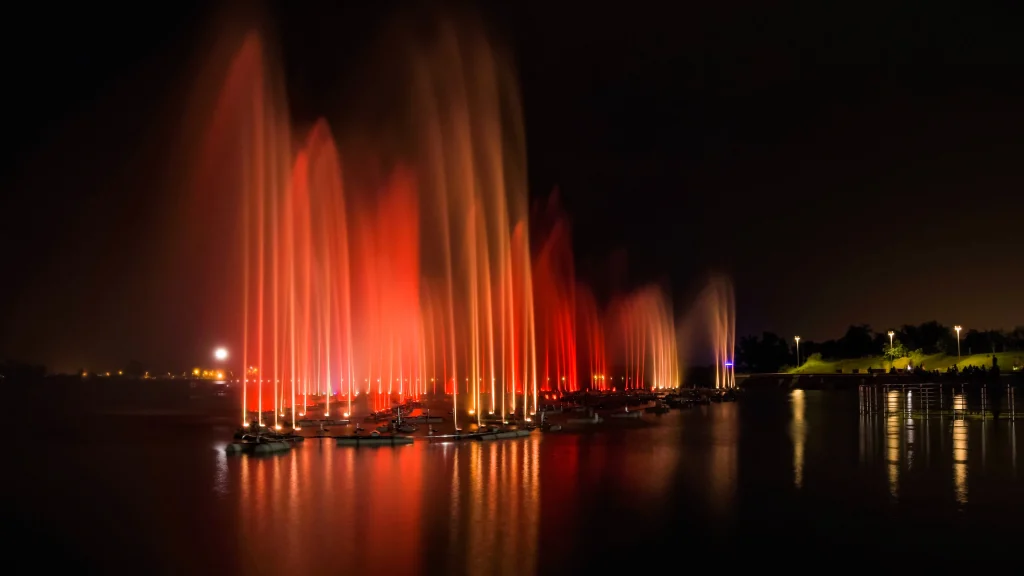How to Design and Construct a 100-Meter High Musical Fountain
Designing and constructing a fountain capable of spraying water 100 meters into the air is a thrilling and complex engineering endeavor. Such fountains create a powerful visual impact and serve as landmarks in large public spaces. However, achieving this height requires careful planning, sophisticated engineering, and specialized equipment. Here’s an in-depth look at how to design and construct a 100-meter-high water spray fountain.
Step 1: Defining Objectives and Analyzing Site Conditions
Before diving into the technical design, it’s essential to clarify your objectives:
- Purpose: Understand if the fountain is purely decorative or part of a larger entertainment feature (such as a musical fountain).
- Budget and Timeline: A high spray fountain requires significant financial investment and time.
- Location Considerations: Site analysis is crucial, considering wind patterns, structural stability, and water source availability. High fountains are best suited for open spaces with minimal obstructions and stable ground.
Step 2: Calculating Hydraulic Requirements
To achieve a spray height of 100 meters, you need substantial water pressure, flow rate, and suitable nozzles:
- Water Pressure: The higher the fountain, the more pressure needed. A 100-meter spray typically requires pressure around 10 bars (145 psi) or higher, depending on nozzle efficiency.
- Pump Selection: High-power pumps are necessary to achieve the required pressure. Selecting the right pump size, usually industrial-grade centrifugal pumps, is essential to consistently sustain this height.
- Water Flow Rate: Flow rate will vary with nozzle size, but high spray fountains often need 500 to 1,000 liters per minute.
- Nozzle Design: The nozzle’s design affects the shape, stability, and height of the water column. For a high spray, single, high-power jet nozzles work best, but they must be tailored for smooth water flow and minimum turbulence.
Step 3: Structural and Mechanical Design
To safely support a 100-meter fountain, a durable structural and mechanical setup is essential:
- Foundation and Basin Design: Ensure the fountain’s basin and foundation are structurally sound. The basin should handle significant water volume, weight, and pressure, with materials resistant to water and corrosion.
- Pipework and Plumbing: Use high-quality pipes to manage the enormous pressure. Stainless steel pipes are recommended for longevity and minimal maintenance.
- Mechanical Support and Anchoring: Mechanical supports are necessary for stability, particularly in high-wind areas, to prevent swaying or structural damage.
Step 4: Electrical System and Automation
A robust electrical and automation system is needed for a 100-meter-high fountain to control pumps, lighting, and effects:
- Power Requirements: A fountain of this scale demands high-voltage power. Ensure compliance with local safety standards and provide a dedicated power source for the pumps and lights.
- Automation Controls: Use Programmable Logic Controllers (PLCs) for efficient pump and lighting control. Automated systems enable consistent height adjustment, monitoring, and energy conservation.
- Lighting Integration: Add LED lighting to highlight the water spray, especially for evening displays. High-intensity, waterproof lighting can create an impactful visual effect without interrupting the flow.
Step 5: Water Management and Filtration
Managing water effectively ensures sustainability, reduces operating costs, and keeps the fountain’s spray visually appealing:
- Water Recycling System: A recycling system helps conserve water by reusing the same water in the fountain basin.
- Filtration and Maintenance: Filtration is essential to maintain clean water flow and prevent nozzle clogging. Regular cleaning schedules are critical for maintaining optimal operation and appearance.
Step 6: Testing and Adjustments
Once construction is complete, rigorous testing is required to ensure that the fountain operates correctly:
- Performance Testing: Start with lower pressures to test structural integrity, gradually increasing until the desired height is reached.
- Wind Sensitivity Adjustments: Adjust the spray pattern based on wind conditions. Consider installing wind sensors to automatically adjust height and avoid water drift in windy conditions.
- Final Calibration: Fine-tune the pump, nozzle, and control systems for consistent performance and reliability.
Step 7: Long-Term Maintenance Plan
To maintain a high spray fountain, plan for regular maintenance:
- Inspections: Periodic inspection of pumps, nozzles, and pipework is crucial for early detection of wear or damage.
- Routine Cleaning: Keep the basin, filtration system, and nozzles clean to ensure consistent performance.
- Seasonal Adjustments: For regions with extreme seasonal changes, reduce height during high winds or winterize the fountain if freezing is possible.
Conclusion
Designing and building a 100-meter-high water spray fountain requires precision engineering, meticulous planning, and ongoing maintenance. With careful attention to detail, safety, and sustainability, a high spray fountain can create an awe-inspiring landmark and a memorable experience for visitors.
Contact US

